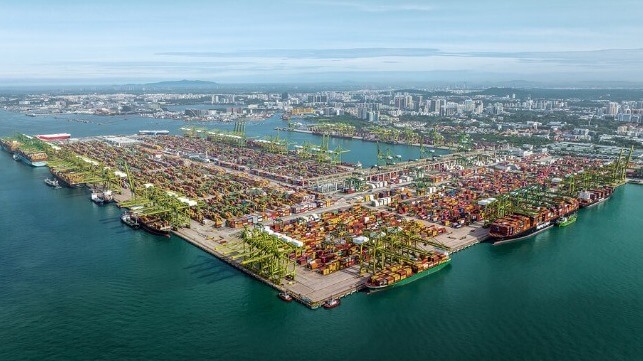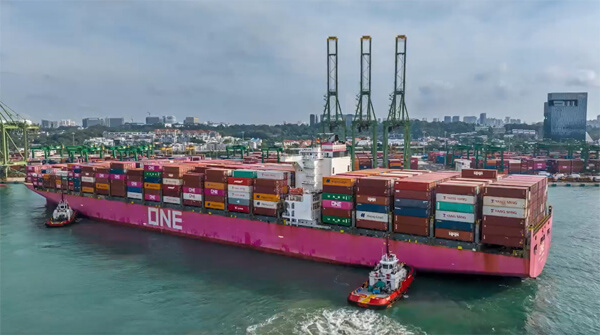Singapore Surpasses Three Billion Gross Tons for Annual Ship Arrivals

The port of Singapore is highlighting its position as a top maritime center as it crossed in 2023 for the first time the three billion gross tonnage mark for ship arrivals. Officials from the port and industry gathered to mark the milestone as Singapore looks to continue to leverage its position to maintain its role as a crossroads in Asia.
The Maritime and Port Authority of Singapore (MPA) announced that the port of Singapore reached this milestone with the arrival of the 98,799 gross tonnage ONE Olympus at the Pasir Panjang Terminal on December 25, 2023. The 2007-built boxship is operating on a run between Asia and Northern Europe and was arriving in Singapore after departing Le Havre, France on November 30 and a transit of the Suez Canal.
The arrival of the 8,628 TEU Singapore-flagged containership means that the annual vessel arrival tonnage for Singapore will exceed three billion gross tons in 2023, up six percent from 2.83 billion GT recorded in 2022. Singapore reached the one billion GT mark in 2004 and two billion GT in 2011.
Port officials said that the achievement demonstrates that the port is maintaining its trend as one of the busiest ports despite geopolitical tensions, economic uncertainty, and instability that have ignited supply chain disruptions and chaos. As another measure of the port’s growth, they reported that in the first half of the year, the port’s container throughput rose by 3.5 percent to 22.46 million TEU. In 2022, the port handled 37.3 million TEU.

ONE Olympus arriving from Europe took the port past the 3 billion GT mark on December 25 (ONE)
While Singapore has made massive investments in hardware, infrastructure, technologies, and operating systems that have made the port of Singapore one of the most efficient, MPA attributed the GT milestone to the strong tripartite cooperation that exists between the unions, industry, and government.
“We are humbled that Singapore continues to be a choice port of call. We will continue to work with all our tripartite stakeholders to improve the efficiency and safety of our port,” said Teo Eng Dih, MPA CEO.
Part of recent initiatives to improve efficiency include the launch of the Just-in-Time (JIT) Planning and Coordination Platform in October this year for vessels calling at PSA terminals and Jurong Port. The platform that in January will expand to include tankers and all vessels at anchorages offers advanced vessel schedule information to reduce waiting time and fuel consumption, leading to cost savings and lower emissions.
Operated by PSA International, Pasir Panjang Terminal is equipped with 18-meter deep water draught, quay cranes with reach across 24 rows of containers and are supported by a fully automated electric yard crane system that is designed to serve the world’s largest container vessels.
Another key factor in Singapore’s growth is the ongoing of its massive new Tuas Port facility which will increase the port’s container capacity by more than two-thirds. Tuas opened its first two berths in December 2021 and was officially opened in September 2022. It will be developed in phases and when completed by the 2040s will have 66 berths and a capacity to handle 65 million TEU each year.
Singapore is a global leader with its primary role of being a transit port. Nearly 80 percent of the cargo handled is transshipment cargo moving across Asia. It is also the world’s largest bunkering port and is moving aggressively to introduce methanol and later ammonia bunkering to maintain its position.
